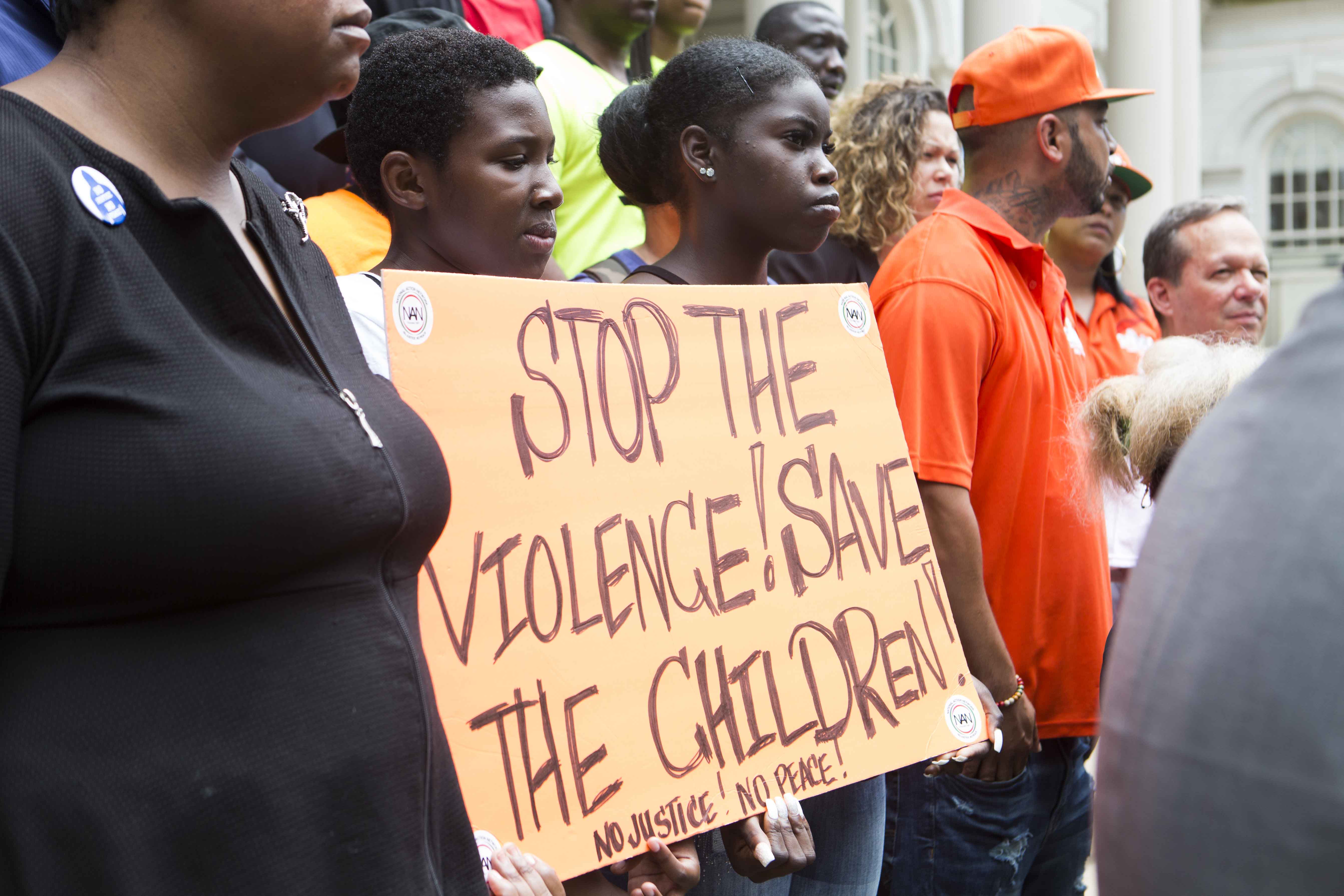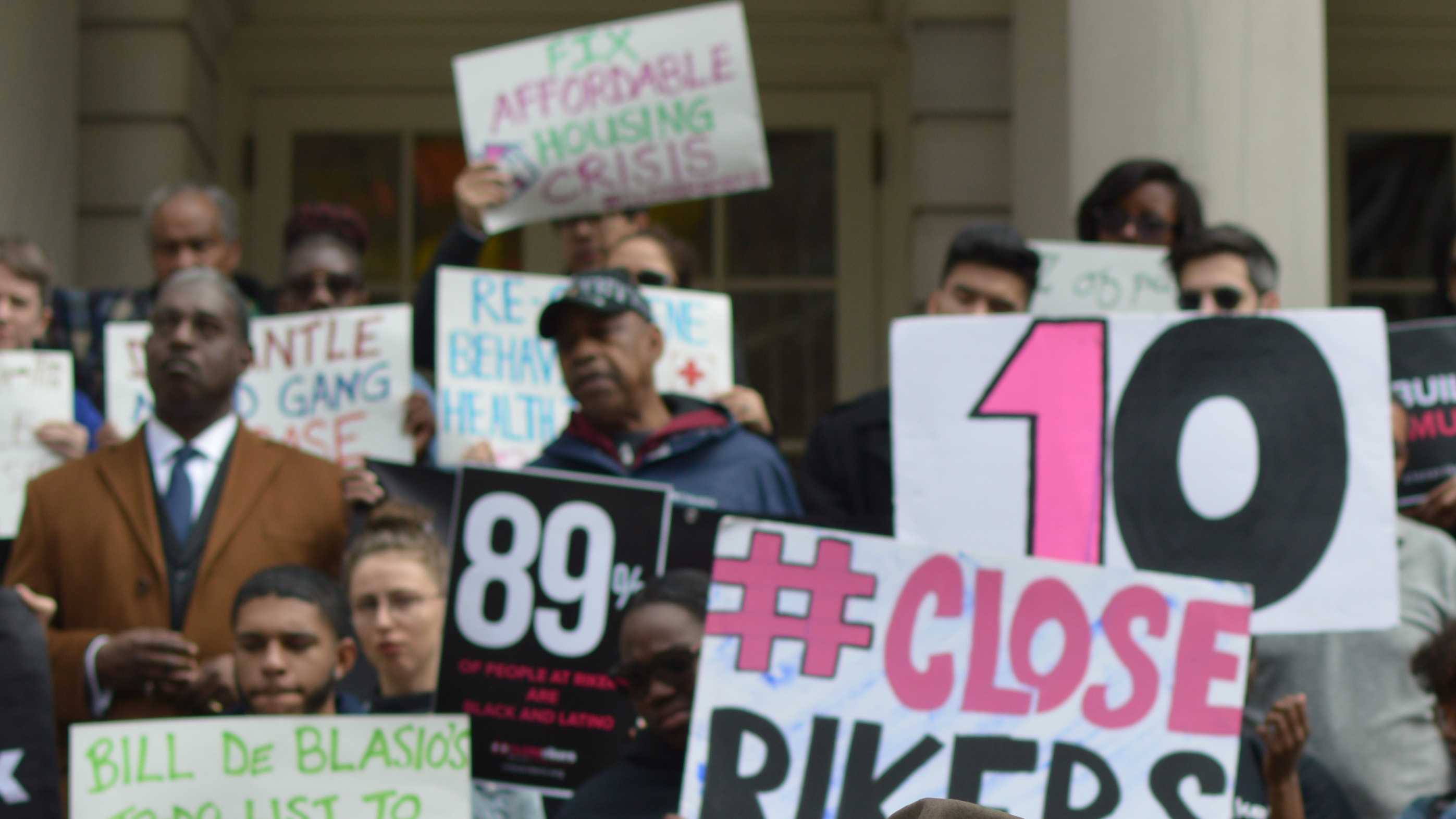- Invest in communities and prevent incarceration through stable housing, mental health services, violence prevention programs, and youth programming.
- Support justice-involved individuals by providing alternatives to detention and incarceration, enhanced reentry services to keep people out of jail and in their communities, as well as reforming the Department of Correction (DOC) and increasing the availability of programming.
- Support communities and neighborhoods surrounding the borough-based facilities by investing in new affordable housing, youth programming, community and cultural centers.
- Change the designs of the borough-based facilities to better integrate into the surroundings communities by reducing the height of the buildings and housing capacity, and a new, and more efficient design.
The vote occurred as Mayor de Blasio, Speaker Johnson and Council leadership agreed to a wide-range of investments tied to the closure of Rikers totaling $391 million dollars, including $126 million in previously planned investments and $265 million in new programming that will address the root causes of incarceration and help fundamentally reshape New York City’s criminal justice system going forward.
This massive decarceration effort establishes New York City as a leader in criminal justice reform and pioneer in ending mass incarceration.
The number of New Yorkers entering jail has declined by nearly half in the past 6 years. The jail population has declined from 11,000 in 2014 to about 7,000 today, and is projected to be approximately 3,300 by 2026.
Votes on Plan to Close Rikers
Rebuild Four Borough-Based Facilities
Subcommittee on Landmarks, Public Siting and Dispositions
Committee on Land Use
Wednesay 10:30am Oct 16, 2019
NYC City Hall
More Info
Read Points of Agreement
Points of Agreement outline the written commitments from the Mayor’s Administration to the City Council
City Council Improvements to the Plan
Reducing Incarceration through Prevention, Diversion, and Reentry
Address the Root Causes of Incarceration Through Investments In Housing and Community-Based Mental Health Services
New neighborhood investments will support communities surrounding the borough-based jails through new affordable housing, youth programming, community and cultural centers.
Design Changes That Better Integrate New Facilities Into Their Surrounding Communities
Details: City Council Improvements to the Plan
Reducing Incarceration through Prevention, Diversion, and Reentry
Highlights of those investments and policy changes include:
- $54 million expansion of pretrial services including Supervised Release, the City’s primary diversion program, which has prevented 15,000 people from entering jail since its inception in March 2016. This program will be expanded to become an option for people facing every type of criminal charge.
- $17 million in new funds to expand and continue Alternatives to Incarceration programs that will now serve 7,300 people per year, which will reduce the number of people serving sentences in City jails.
- Mayor’s Office of Criminal Justice will invest in a planning grant for The Imagining Project, a collaboration between the Brooklyn District Attorney Eric Gonzalez and the Columbia University Justice Lab, an organization whose long term mission is to create a plan for getting to zero incarceration and minimal convictions for youth age 25 and under. A similar effort with the Center for Court Innovation will create a community justice center to provide community-based programming in the Far Rockaways, with a focus on providing alternatives to arrest and incarceration and reducing recidivism post-incarceration.
- Building on the existing investment in in-custody programming and reentry services, the City is restructuring such services to ensure access to comprehensive social services and access to paid transitional employment post-release for everyone leaving City jails.
- Services to support incarcerated individuals facing medical and mental health issues, including: doubling the number of therapeutic treatment units in the jails, known as the Program for Accelerated Clinical Effectiveness, or PACE; expanded mental health discharge planning services; and a new program to help ensure continuity of medical care for those exiting City jails.
- Expanded programming for social and emotional learning to help school communities be more proactive in changing school culture and climate, with the goal to foster and maintain a supportive school environment while reducing conflict.
- Requiring every detention facility to have dedicated administrative space for community based providers as well as dedicated space for services and programming in every housing unit. Also requiring new trainings for correction officers, program staff, and healthcare staff to participate in together.
- Expanded pre-arraignment diversion that will allow more people to avoid prosecution and have their arrests sealed
- Increased funding to community-based restorative justice programming, with a particular focus on serious felony level cases that would otherwise result in detention and incarceration. This model will invest in community-based infrastructure in conjunction with the District Attorneys and courts.
- Commitment to build a Community Justice Fund through a public-private partnership managed by the Mayor’s Fund that would strengthen the fabric of community justice and safety by focusing on developing programming and policies for truly communities based investments.
Address the Root Causes of Incarceration Through Investments In Housing and Community-Based Mental Health Services
- The City will increase to 1,000 the number of supportive and transitional housing units dedicated to serving people who are homeless, have health needs, and histories of justice involvement.
- In addition to the investment in expanding the Justice Impacted Supportive Housing (JISH) Program from 120 to 270 beds, the City will create an additional 230 JISH units for people who are homeless with a history of justice involvement. This brings the total JISH bed commitment to 500 units.
- In addition to baselining the City’s current $5 million investment in transitional housing for people with justice involvement, the City will increase funding to $25M (increasing the number of units from 100 to 500 by FY23) for transitional housing services enable people to avoid jail by participating in ATDs and ATIs and stabilize post-release.
- Commitments, adopted from the NYCCrisis Prevention and Response Task Force recommendations that ensure people with behavioral health needs are provided medical treatment and community-based responses to limit justice-involvement.Highlights of these investments include 8 new New Health Engagement and Assessment (HEAT) teams to proactively engage people at risk of mental health crises. These teams – which include one clinician and one peer – connect people to care and other stabilizing support, preventing mental health needs from becoming crises.
- Other highlights include six Mobile Crisis Teams, which ensure a more rapid response by mental health professionals and peers to those in mental health distress, and 4 new Intensive Mobile Treatment teams, which provides proactive and sustained engagement with those individuals with behavioral health needs. This commitment will also include 4 new co-response teams in high need precincts, in which police officers and mental health clinicians work together to respond to 911 calls involving those in mental health distress.
Community-Based Violence Reduction
- 25th Precinct in East Harlem, encompassing New York City Housing Authority’s (NYCHA’s) Senator Robert F. Wagner, Sr. Houses
- 40th Precinct in the Mott Haven section of the Bronx, encompassing NYCHA’s Judge Lester Patterson Houses and Mitchel Senior Center Houses
New neighborhood investments will support communities surrounding the borough-based jails through new affordable housing, youth programming, community and cultural centers.
These local investments include:
- New programming and recreation spaces for young people that give them safe and productive environments. This includes two new community centers in the South Bronx at 1080 Ogden Avenue and at 337 East 139th Street, and investments in NYCHA community centers in the South Bronx at Mill Brook, Mitchel, Patterson and Mott Haven Houses.
- New affordable housing in the South Bronx at 351 Powers Avenue and 320 Concord Avenue.
- Capital improvements at Samuel Gompers High School, and P.S. 99 and P.S. 139 in Queens. Technology investments for P.S. 65 in the South Bronx
Design Changes That Better Integrate New Facilities Into Their Surrounding Communities
Negotiations between the Mayor’s Office and Council resulted in additional improvements to the City’s plan to build borough-based jail facilities to prioritize therapeutic environments, and culture change in all aspects of the borough-based jail system, and to better integrate DOC and programmatic staff.
About 40% of the housing units across the borough-based system will be dedicated therapeutic units with specific staffing and services to better serve people with mental health, substance use, and complex medical needs.
This effort was born from a commission created by the City Council in 2016, and led by former New York State Chief Judge Jonathan Lippman, to study how to improve our jail system and our criminal justice system as a whole.
Through months of engagement, both locally in communities with proposed jail sites, and also more broadly with criminal justice stakeholders, the plan to site borough-based jails evolved to maximize investments in addressing the underlying causes of incarceration, transform our justice system, and respond to local community-based concerns about building scale.
In addition, to ensure that Rikers Island is never again used to incarcerate people, the City Council voted today to initiate a City Map change that will restrict the use of detention centers on Rikers Island after December 31, 2026, thus requiring such facilities to close.
Additional details are outlined in the Points of Agreement letter signed by the Mayor and received by the Council.
| Borough | Initial Proposed Height | Initial Propose Floor Area Ratio (FAR) | City Planning Changes to Height | City Planning Changes to FAR | Council Changes to Height | Council Changes to FAR |
| Bronx | 245’ | 7.41 | 245’ | 6.87 | 195’ | 5.4 |
| Brooklyn | 395’ | 17.95 | 395’ | 16.36 | 295’ | 11.9 |
| Manhattan | 450’ | 12.95 | 450’ | 12.58 | 295’ | 10.11 |
| Queens | 270’ | 4.41 | 270’ | 4.25 | 195’ | 3.71 |
Population at Rikers Island
The burden of being incarcerated disproportionately falls on people of color.
As of August 27, 2019, there were 7,110 people incarcerated in New York City.
The majority – 67% – were there pretrial, meaning they are presumed innocent.
Almost all are men, about 94%, and almost all are people of color, 89%.
People in Custody
Dept. of Correction Facilities, 2017-2019
People in Custody
Dept. of Correction Facilities
Total
7,110 People
August 27, 2019
Pretrial (Presumed Innocent)
67%
4,764 People
People in Custody: Detained or Sentenced
Dept. of Correction Facilities, June 2017 – June 2019
Movement Towards Closure
The movement to close Rikers Island gained significant momentum in 2016, when advocates who had spent time there began mobilizing.
On February 11, 2016, former New York City Council Speaker Melissa Mark-Viverito announced the creation of a commission to explore closing jail facilities on Rikers Island.
The Commission began its work in 2016, and released its report and recommendations in April of 2017.
The Commission unanimously concluded that jail facilities on Rikers Island should be closed, and in the following year announced that existing borough-based facilities should be modernized and made more humane as part of a borough-based system.
Where People in Custody on Rikers Island Live in NYC
By Zip Code, June 2017 – June 2019
The Public Review Process
His Administration advanced plans to site four jails in Manhattan, Brooklyn, Queens and the Bronx.
The public review process to seek the regulatory approvals for the four new jails started in March 2019, with Community Boards and Borough Presidents reviewing and voting on the project.
The City Planning Commission voted to approve the borough-based jails plan on September 3, after which the project began review by the City Council.
The City Council listened to community and stakeholder feedback since 2016 and throughout the public review process, and sought additional feedback at a public hearing on September 5, 2019, 10:00 AM, at City Hall, in Council Chambers.
The City Council cast its final vote in favor of the project on October 17, 2019.





